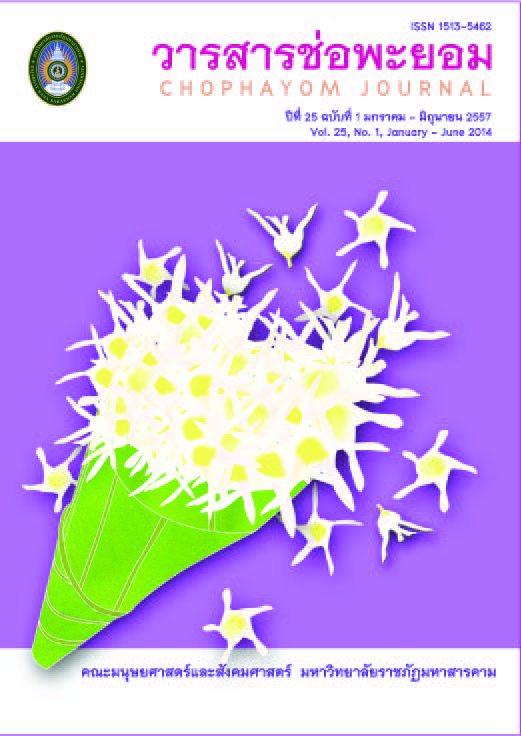รูปแบบการพัฒนาชุมชนอยู่ดีมีสุข : กรณีศึกษาบ้านกุดซุย อำเภอเมือง จังหวัดมหาสารคาม (A Model for Developing Well-Being Community : A Case study Kudsui Village, AmphoeMueangMahasarakham Province)
Abstract
บทคัดย่อ
การวิจัยครั้งนี้มีวัตถุประสงค์เพื่อ 1) ศึกษาบริบทของปัญหาและความต้องการของชุมชนในการพัฒนาชุมชนอยู่ดีมีสุข บ้านกุดซุย อำเภอเมือง จังหวัดมหาสารคาม2) เพื่อสร้างรูปแบบการพัฒนาชุมชนอยู่ดีมีสุขบ้านกุดซุย อำเภอเมือง จังหวัดมหาสารคาม 3) เพื่อทดลองใช้และประเมินผลรูปแบบการพัฒนาชุมชนอยู่ดีมีสุขบ้านกุดซุย อำเภอเมือง จังหวัดมหาสารคามกลุ่มเป้าหมายที่ใช้ในการวิจัยคือชุมชนในบ้านกุดซุย จำนวน 40ครัวเรือน เครื่องมือที่ใช้ในการเก็บรวบรวมข้อมูลเป็นแบบสอบถาม มีค่าเชื่อมั่น 0.98 สถิติที่ใช้ในการวิเคราะห์ข้อมูลคือค่าความถี่ ค่าร้อยละ ค่าเฉลี่ย ค่าเบี่ยงเบนมาตรฐาน และการสอบความแปรปรวนหลายตัวแปรตาม (MANOVA : Repeated Measure) ผลการวิจัยพบว่า 1) ปัญหาของชาวบ้านส่วนใหญ่เป็นปัญหาสังคมปัญหาคุณภาพชีวิต และความต้องการของชุมชน ชาวบ้านมีความต้องการความรู้เกี่ยวกับการประกอบอาชีพเพื่อนำไปฝึกปฏิบัติสร้างรายได้ เช่น การปลูกผักปลอดภัยจากสารพิษ การทำปุ๋ยชีวภาพ การเพาะเห็ดขอนขาว การเพาะเห็ดนางฟ้า การเลี้ยงวัว การเลี้ยงกบ เกษตรอินทรีย์ การเลี้ยงจิ้งหรีด การเลี้ยงปลาดุก การเลี้ยงไก่พันธุ์สามสายเลือดและการเลี้ยงไก่พันธุ์พื้นเมืองตามลำดับ 2)รูปแบบการพัฒนาชุมชนอยู่ดีมีสุข แบ่งเป็น 4 ขั้นตอนได้แก่ การสร้างความสัมพันธ์ศึกษาสภาพปัญหาและความต้องการของชุมชน, การวิเคราะห์ปัญหาและพิจารณาความเป็นไปได้ของโครงการ, ทดลองและประเมินผลการใช้, การสร้างความรู้ให้ชุมชน 3)ความอยู่ดีมีสุขและความพึงพอใจต่อรูปแบบการพัฒนาชุมชนอยู่ดีมีสุขโดยหลังการเข้าร่วมโครงการวิจัยสูงกว่าก่อนเข้าร่วมโครงการวิจัยประชาชนในชุมชนมีความอยู่ดีมีสุขโดยรวมอยู่ในระดับมากและมีความพึงพอใจผลที่ค้นพบก็คือทำให้ครัวเรือนเกิดผลดีทางด้านการลดค่าใช้จ่ายและการเพิ่มรายได้และทำให้มีความสุขความพึงพอใจมากขึ้น
คำสำคัญ: รูปแบบการพัฒนาชุมชนอยู่ดีมีสุข, ชุมชนอยู่ดีมีสุข
Abstract
The objective of the study research were to study context, problems and needs assessments of community, design a model of well-being community development, and trial and evaluation the model. The samples were forty families leaders in Kudsui Village, Muang District, MahaSarakham province, who voluntarily participated in the well-being community development project . The research instrument were an evaluation form, an interview form. The collected data were analyzed by the use of percentage, a mean, a standard deviation, and for testing hypothesis the MANOVA ( Repeated Measure) Theory is taken as a basis for this research is theories of human development and the concept of public participation the research findings were summarized as follows 1. Villagers and chief household of Kudsui Village the most problem is social problem and life problem. The problems which includes illegible and can't write 4.00 percent of citizen, unmoral and unethical in social 12 percent, participation of develop yourself and social 15 percent, people don't have knowledge about roles themselves 8 percent, and agriculture problem including lack of irrigation systems, lack of funding and lack of income. In addition villagers want to have knowledge about the profession to practice for extra income such as growing vegetables safe from toxins, making organic fertilizer, implantation white timber mushroom, implantation angel mushroom, cowboys, In addition villagers want to have knowledge about the profession to practice for extra income such as growing vegetables safe from toxins, making organic fertilizer, implantation white timber mushroom, implantation angel mushroom, cows farming, frogs farming , organic agriculture, crickets farming, fishes farming, three pedigree chicken farming and chickens native species farming etc.
2. The model of well-being community development consisted of four steps: 1) establishment of relations, analysis of problems and need assessments, 2) design of well-being community development model 3) trial and evaluation of the model, and 4) providing training course to problem in community.
3. Chief household well-being by 3 aspect which include, Technology, Wisdom and Learning proper, Economic Community a strong, and Management community a strong overall at high levels in all aspects satisfaction with the model for development of community well-being.
Before partake project research with after partake project are differences statistically significant at the .05 level by after partake the project is higher before partake the project. The result shows that the model developed to community well-being practices making household reducing costs and increasing revenue and made a happy satisfied than ever.
Keyword :A Model for Developing Well-Being Community, Well-Being Community





